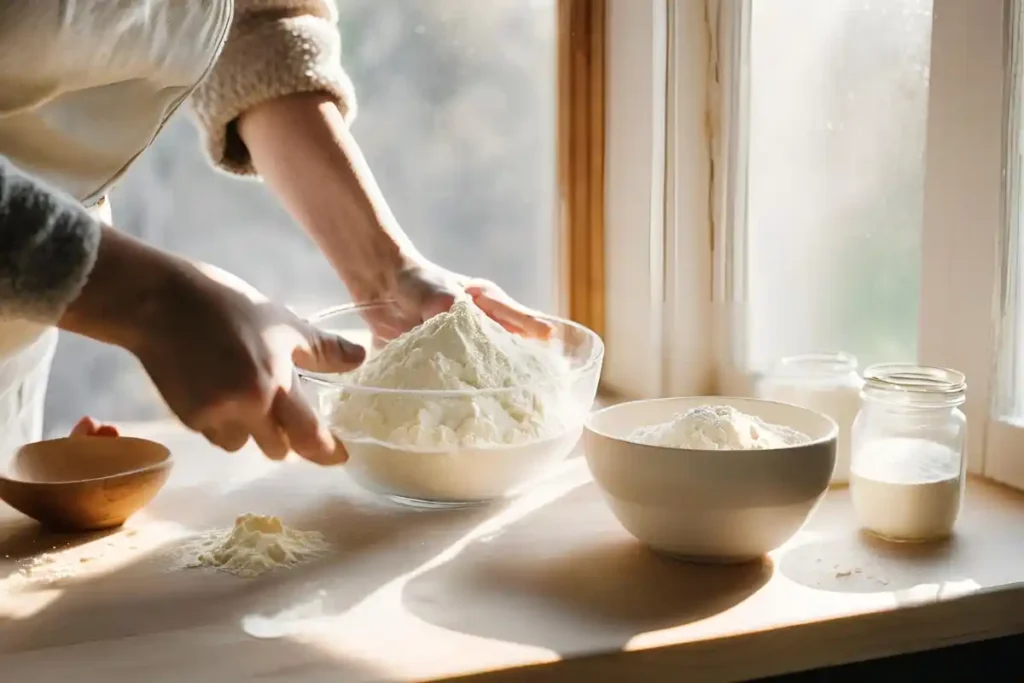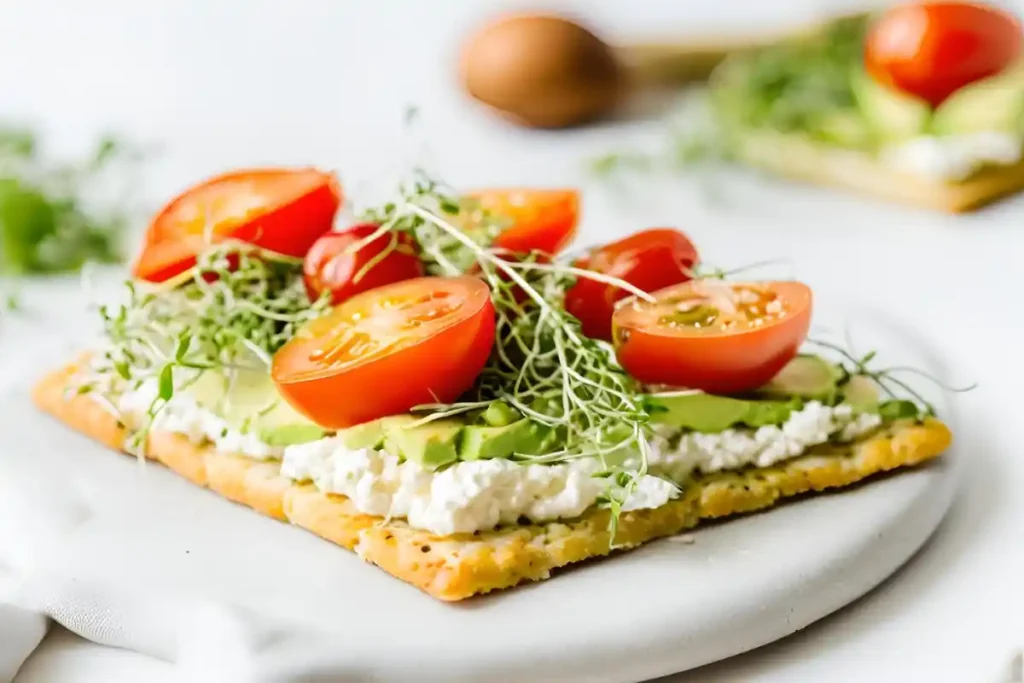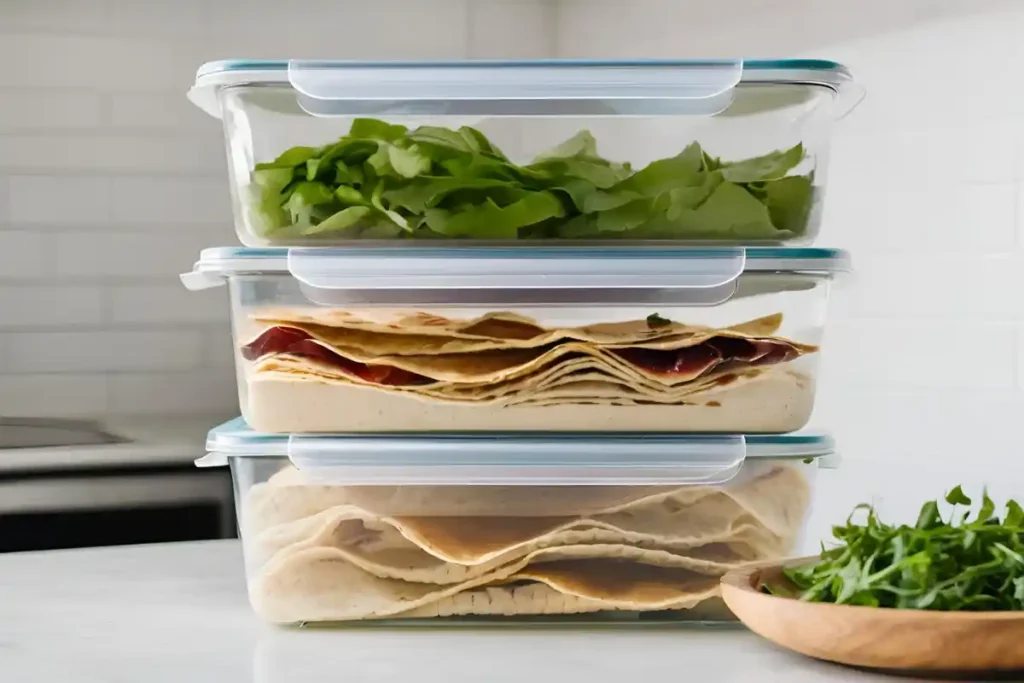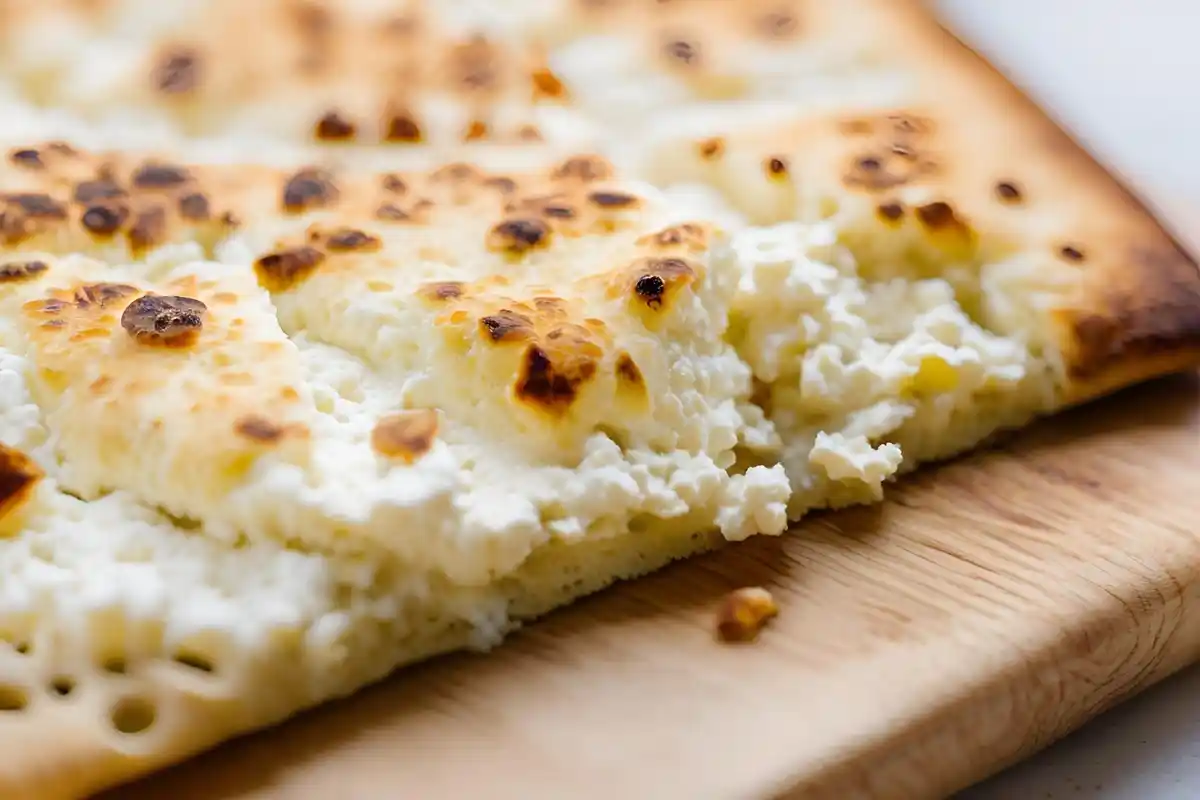Cottage Cheese Flatbread Recipe
What is Cottage Cheese Flatbread?
If you’re into flatbreads, you’re in for a treat with cottage cheese flatbread! This isn’t your average flatbread—it’s got a creamy, slightly tangy twist that makes it a standout option for any meal. Imagine the soft, pillowy texture of traditional flatbread but with a subtle richness that comes from the inclusion of cottage cheese. Whether you’re a fan of sweet or savory flavors, this flatbread adapts beautifully to all kinds of toppings.
Unique Characteristics of Cottage Cheese Flatbread
So, what makes this flatbread unique? First off, it’s packed with moisture thanks to cottage cheese, which keeps it tender without feeling heavy. Plus, cottage cheese adds a distinct flavor—a little tangy and a bit cheesy, but nothing too overpowering. In terms of texture, you get this incredible balance between a soft center and a slightly crisp exterior when cooked just right.
But there’s more! Unlike traditional flatbreads, which often rely on just flour, water, and yeast, this version has extra protein and calcium, making it a surprisingly nutritious option.
Differences Between Cottage Cheese Flatbread and Traditional Flatbread
Let’s talk differences. Traditional flatbread tends to lean on simplicity, often relying on yeast or baking powder to get a bit of rise and structure. However, cottage cheese flatbread shakes things up by incorporating dairy for a richer taste and improved nutritional profile. Additionally, this recipe is far more forgiving—because cottage cheese provides natural moisture, you’re less likely to end up with a dry or crumbly result. And for those who are short on time, this flatbread can skip the yeast altogether for a quicker prep!
Why Use Cottage Cheese in Flatbread?
Using cottage cheese isn’t just about flavor (though that’s a huge bonus!). It’s a game-changer when it comes to nutrition and versatility.
Nutritional Benefits of Cottage Cheese
Cottage cheese is a powerhouse of protein, which means this flatbread can keep you fuller for longer—a win for anyone looking for healthy meal options. It’s also loaded with calcium, which is great for bone health. And if you’re watching your carbs or calories, cottage cheese offers a lower-calorie alternative to other cheeses while still delivering a satisfying creaminess.
Flavor and Texture Enhancements
Aside from its nutritional perks, cottage cheese brings serious upgrades to flavor and texture. Its mild taste doesn’t overpower other ingredients, so you can pair this flatbread with almost anything. Meanwhile, its creamy consistency ensures the dough stays moist during baking or cooking, which means no dry, disappointing bites here!
Who Will Love This Recipe?
This recipe is perfect for so many people—whether you’re a seasoned baker or someone who’s just getting started in the kitchen.
Ideal for Health-Conscious Bakers
If you’re all about nutritious cooking, you’ll love how this flatbread sneaks in protein and calcium without compromising on flavor. Plus, the option to use whole-grain or gluten-free flours means it can fit into almost any diet. For those looking to cut back on processed foods, making your own flatbread at home is a total no-brainer.
Perfect for Quick and Easy Meal Preps
This flatbread is a lifesaver for busy schedules. The dough comes together quickly, and the flatbread cooks up fast, whether you’re using a skillet or an oven. It’s versatile enough to work as a quick snack, a meal base, or even a party appetizer. So, if you love recipes that are as convenient as they are delicious, this one’s for you!
Here’s the content for Part 2 based on the outline:
Ingredients for Cottage Cheese Flatbread
Making cottage cheese flatbread doesn’t require a ton of fancy ingredients, which is one of the reasons it’s so easy to love. Each component serves a specific purpose, so let’s break it down.
Essential Components
Cottage Cheese – Key Role in Baking
Cottage cheese is the star of the show here. It doesn’t just add flavor—it also helps keep the dough moist and soft, making it easier to handle and less likely to dry out during cooking. Plus, the natural creaminess enhances the texture of the flatbread, giving it a tender, almost melt-in-your-mouth quality.
Flour Options – Gluten-Free and Whole-Grain Variants
When it comes to flour, you’ve got options. All-purpose flour is a reliable choice for a classic texture, but if you’re gluten-free or aiming for a healthier twist, alternatives like almond flour, chickpea flour, or whole-grain flours work beautifully. Each type of flour adds its own spin on texture and flavor, so feel free to experiment.
Flavor Additions – Herbs, Spices, and Toppings
Here’s where the fun begins! You can mix herbs like rosemary or parsley into the dough for an earthy flavor or sprinkle spices like garlic powder, paprika, or cumin for a more robust taste. And don’t forget toppings—anything from sesame seeds to shredded cheese can give your flatbread a finishing touch that’s as unique as your cravings.
Choosing the Right Cottage Cheese
Not all cottage cheese is created equal, so selecting the right type is key.
Full-Fat vs. Low-Fat Cottage Cheese
Full-fat cottage cheese delivers maximum creaminess, which is fantastic for achieving a softer flatbread. On the other hand, low-fat options work well if you’re cutting calories or fat content, though you might notice a slightly firmer texture. Either way, the recipe is adaptable—you can’t go wrong!
Pre-Packaged vs. Homemade Cottage Cheese
Pre-packaged cottage cheese is convenient and consistent, making it a go-to for most home bakers. However, if you’re feeling adventurous, homemade cottage cheese offers a fresher, more customizable option. It’s surprisingly easy to make and allows you to control the salt and creaminess levels to suit your taste.
How to Make Cottage Cheese Flatbread

Ready to dive in? Here’s a step-by-step guide to ensure your flatbread comes out perfect every time.
Step-by-Step Preparation Guide
Mixing the Dough
Start by combining your cottage cheese with your choice of flour and seasonings. For a smooth dough, mix until everything is evenly incorporated—it might feel a little sticky, but that’s a good sign! If the dough feels too wet, you can gradually add more flour until it’s manageable.
Rolling and Shaping Techniques
Dust your countertop with flour to prevent sticking, and use a rolling pin to shape the dough into thin, even rounds. Keep in mind that the thickness of the flatbread will affect the cooking time and texture. Thinner dough will yield crispier flatbread, while thicker rounds will be softer and chewier.
Cooking Methods: Pan vs. Oven Baking
For quick cooking, a hot skillet is the way to go. Cook each side for a few minutes until golden brown. Alternatively, bake the flatbread in a preheated oven for a more hands-off approach. Both methods work wonderfully, so it’s really about your preference!
Key Tips for Perfect Flatbread
Avoiding Soggy Flatbread
One common issue with cottage cheese flatbread is excess moisture. To avoid sogginess, make sure to drain any liquid from the cottage cheese before mixing it into the dough. Also, don’t overdo it with wet toppings, as they can make the flatbread too soft.
Ensuring Even Cooking
Consistency is everything. Make sure your dough is rolled out evenly—this helps avoid undercooked spots. And whether you’re using a skillet or an oven, keep an eye on the heat to prevent burning. Medium heat is usually your best friend here.
Troubleshooting Cottage Cheese Flatbread Issues
Even the best recipes have their hiccups, but no worries—we’ve got solutions for common problems.
Why Is My Cottage Cheese Flatbread Soggy?
Common Mistakes and How to Fix Them
Soggy flatbread often comes down to too much moisture. This can happen if your cottage cheese isn’t well-drained or if your dough is too wet. To fix this, pat the cottage cheese dry with a paper towel before mixing it into the dough. You can also sprinkle a little extra flour to absorb excess liquid.
Tips for Adjusting Cooking Times and Temperatures
If your flatbread is soggy in the middle but golden on the outside, it might need more time to cook at a slightly lower temperature. This helps the inside cook through without burning the exterior.
How to Tell When Cottage Cheese Flatbread Is Done?
Visual and Textural Cues
Perfect flatbread will be golden brown with slightly crisp edges. The texture should feel firm but still pliable—almost like a soft tortilla. If it feels too soft or doughy, it probably needs a little more time on the heat.
Using a Thermometer for Accuracy
For extra precision, use a food thermometer to check the internal temperature. A fully cooked flatbread should reach around 200°F in the center. This step is optional but helpful for achieving consistently great results!
Here’s the content for Part 3 based on the outline:
Serving Ideas for Cottage Cheese Flatbread

One of the best things about cottage cheese flatbread is its versatility. Whether you’re in the mood for a light snack or a hearty meal, this flatbread can do it all.
Pairing Flatbread with Toppings
Sweet Variations – Honey and Fruits
For a sweet twist, you can also explore recipes like our Cottage Cheese Banana Bread that highlight the natural pairing of dairy and fruits.
If you’ve got a sweet tooth, this flatbread pairs beautifully with honey, fresh fruits like berries, or even a smear of Nutella. For a healthy spin, top it with a dollop of Greek yogurt and a sprinkle of granola. These options are perfect for breakfast or a mid-day treat.
Savory Options – Vegetables and Protein
For savory fans, the sky’s the limit. Think roasted vegetables, hummus, or avocado slices. You can also go the protein-packed route with shredded chicken, smoked salmon, or scrambled eggs. A sprinkle of feta or grated Parmesan adds a delicious finishing touch.
Meal Ideas Featuring Cottage Cheese Flatbread
Breakfast, Lunch, and Dinner Uses
Start your day with a breakfast wrap using cottage cheese flatbread as the base—fill it with scrambled eggs, spinach, and a little salsa. For lunch, try using it as a base for flatbread pizza with tomato sauce, mozzarella, and your favorite toppings. And for dinner, it’s great as a side to soups, stews, or curries.
Snacks and Party Food Inspiration
This flatbread also shines as a snack. Cut it into strips and serve with dips like tzatziki, guacamole, or baba ghanoush. For parties, you can create mini flatbread appetizers with a variety of toppings—think bruschetta, caprese, or smoked salmon with cream cheese.
Storage and Reheating Tips

To get the most out of your flatbread, proper storage and reheating are key.
Keeping Flatbread Fresh
Refrigeration and Freezing Guidelines
If you plan to eat the flatbread within a couple of days, store it in an airtight container in the refrigerator. For longer storage, wrap each piece in plastic wrap and freeze. When freezing, place the wrapped flatbreads in a zip-top bag to keep them fresh for up to two months.
Reheating Techniques for Best Results
To reheat, you have a few options. For a crispier texture, use a hot skillet—just heat each side for about 30 seconds. Alternatively, pop it in the oven at 350°F for a few minutes to warm it through. Avoid the microwave if you can, as it can make the flatbread rubbery.
Final Thoughts on Cottage Cheese Flatbread
Why This Recipe Is Worth Trying
There’s something special about a recipe that’s both easy and satisfying. Cottage cheese flatbread is a delicious way to incorporate extra protein and calcium into your meals without compromising on flavor. Plus, its versatility makes it a great addition to any meal plan.
Encouragement to Experiment with Variations
Don’t be afraid to get creative! Whether you want to try different flours, mix in new seasonings, or explore unique topping combinations, this recipe is a fantastic starting point. Cooking is all about experimenting and finding what works for you—and this flatbread is a canvas for all kinds of delicious ideas.
Here’s the content for Part 4 based on the outline:
FAQs
Why Is My Cottage Cheese Flatbread Soggy?
How Moisture Content in Ingredients Affects Texture
The main culprit for soggy flatbread is excess moisture in the dough. Cottage cheese naturally contains water, so if it isn’t properly drained before mixing, it can make the dough too wet. Additionally, overly wet toppings or undercooking can leave your flatbread feeling soggy. To fix this, always pat the cottage cheese dry and avoid overloading the flatbread with moist ingredients.
How to Tell When Cottage Cheese Flatbread Is Done?
Signs of Properly Cooked Flatbread
Done flatbread should be golden brown and have a slight crispness on the edges while remaining soft in the center. If it looks pale or feels overly soft, it likely needs more cooking time. A quick press with your finger—if it springs back gently—it’s ready.
What Does Cottage Cheese Do in Baking?
Enhancing Texture and Flavor with Cottage Cheese
Cottage cheese acts as a secret weapon in baking. It adds moisture, making the flatbread tender and pliable, while its mild tangy flavor enhances the overall taste. It also helps to increase the protein content, giving the flatbread more structure without the need for extra flour or eggs.
How to Keep Cottage Cheese Flatbread from Sticking?
Preparing the Cooking Surface
A good non-stick surface is key. Dusting your countertop and rolling pin with flour can prevent the dough from sticking while you shape it. If you’re cooking on a skillet or baking sheet, ensure it’s well-oiled or use parchment paper for hassle-free results.
Proper Handling of Dough
Handling the dough with slightly floured hands can make shaping easier. Avoid pressing too hard, as this can cause the dough to stick or tear.
Can I Use a Substitute for Cottage Cheese in Flatbread?
Exploring Alternatives Like Yogurt or Ricotta
Yes, you can! Greek yogurt is a great alternative, offering a similar tangy flavor and creamy texture. Ricotta cheese also works well, though it’s slightly sweeter and less tangy than cottage cheese. Keep in mind that substitutions may require slight adjustments to the amount of flour due to differences in moisture levels.
How Long Does Cottage Cheese Flatbread Last?
Shelf Life and Safe Storage Practices
Cottage cheese flatbread can last up to three days when stored in the refrigerator in an airtight container. For longer storage, freeze it for up to two months. Always check for changes in texture or smell before consuming leftovers.
Can Cottage Cheese Flatbread Be Made Gluten-Free?
Adapting the Recipe with Gluten-Free Flour
Absolutely! Substitute all-purpose flour with a gluten-free alternative like almond flour, oat flour, or a pre-mixed gluten-free baking blend. You may need to adjust the moisture content slightly, as gluten-free flours often behave differently than wheat-based ones.

